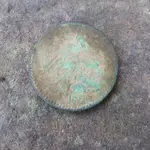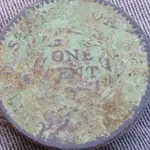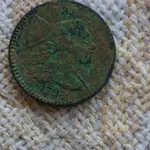I would recommend forgoing the baking soda as it is abrasive, the soap and water as some soaps can change the toning or color of Copper coins and while others recommend using Hydrogen Peroxide, I have found that it can and will damage some Copper coins and sometimes strips then down to the raw pinkish Copper. First off, I would recommend rinsing the coin with water or bath it in water for awhile to remove or dilute any contaminants that may have been in the ground where the coin was dug. Pat the coin dry with a soft towel, then transfer it into an Acetone bath for 5 to 10 minutes making sure to rotate it occasionally. This will arrest the verdigris (the green stuff seen on the coin) that is eating away at the metal in the coin and causing further damage. Once done with the Acetone bath, rinse the coin with water and again pat dry with a soft towel. Next, transfer the coin into a long soaking bath of either (**) Extra Virgin Olive Oil, Mineral Oil or Kroll Oil. Rotate the coin every day or so to ensure that both sides are equally treated. After a week, see if some of the compacted dirt, grime and/or encrustations can be removed with a green Rose Thorn or even a light rub of a soft fingertip. Warning: Do not rub the coin vigorously as this can cause the loosened dirt, grime and/or encrustations to scratch the coin's surfaces. The coin may have to soak in the Extra Virgin Olive Oil, Mineral Oil or Kroll Oil for several weeks or even several months to obtain the desired results. Once you feel that no more dirt, grime and/or encrustations can be removed, rinse the coin very well with water, pat dry between the folds of a soft towel, let air dry for 30 minutes to an hour, then place the coin in a protective 2x2 coin holder. (**) Note: Some folks prefer using Mineral Oil or even Kroll Oil over Extra Virgin Olive Oil. This is due to the fact that Extra Virgin Olive Oil can and will turn some Copper coins darker the longer it remains soaking in it. Myself, I normally use Extra Virgin Olive Oil, especially on heavily encrusted coins due to the slight acidity in the Oil which tends to eat away and loosen encrustations more readily than the other two Oils. Of course, an individual could try one of the Oils and if it doesn't appear to be working or working well, one could always switch to another Oil. Just make sure that before transferring the coin from one Oil to another Oil, rinse the coin with water and pat dry first to prevent cross contamination of the Oils which possibly could reduce their effect.
I also want to congratulate you on a nice 1794 Liberty Cap Large Cent find!
Frank














